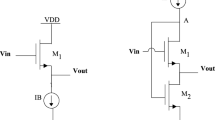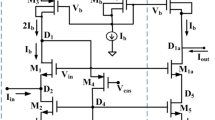Abstract
Second generation current conveyor (CCII) is a versatile fundamental building block that is used nowadays for designing of almost all kinds of current mode devises. A wide variety of CCII configuration offering diverse characteristics have been proposed in literature. However, not much effort has been put to improve the output resistance of this block. High output resistance is a very essential parameter that makes CCII a versatile block to be used in integrated circuits, without affecting its performance parameters. In this paper, an extensive survey has been carried out to explore high performance CCII topologies. Among these configurations flipped voltage follower (FVF) based class-A CCII architecture has been chosen because of its compact design, low voltage and current/voltage matching characteristics. Output resistance of this configuration has been increased by using super-cascode (SC) configuration and replacing the biasing circuitry by low voltage cascode current mirror. Small signal analysis of the proposed circuit has been carried out to mathematically validate the improvement achieved by this circuit. The proposed FVF based class-A SC-CCII offers very high output resistance while maintaining all the characteristics of FVF based class-A CCII. However, a small sacrifice has to be made in the required in supply voltage of the proposed design. The proposed CCII is simulated in LtSpice using 0.18 µm CMOS technology and is compared with various CCII configurations available in literature. The simulated results validate the high performance operation of the proposed SC-CCII and show that this block offers around 70 times increase in output resistance. The characteristic of this proposed SC-CCII makes it a versatile block to be used in wide applications with diverse characteristics.

















Similar content being viewed by others
Abbreviations
- CCII:
-
Second generation current conveyor
- FVF:
-
Flipped voltage follower
- SC:
-
Super-cascode
- Opamp:
-
Operational amplifier
- VM:
-
Voltage mode
- GBP:
-
Gain bandwidth product
- CM:
-
Current mode
- CC:
-
Current conveyor
- DCCII:
-
Differential second generation current conveyor
- CCCII:
-
Controlled current conveyor II
References
Franco S 2015 Design with operational amplifiers and analog integrated circuits. 4th edn. Mc Graw Hill Education, India, pp. 1–66
Salem S B, Fakhfakh M, Sellami D, Loulou M, Loumeau P and Masmoudi N 2006 A high performance CMOS CCII and high frequency applications. Analog Integr. Circuits Signal Process. 49: 71–78
Sedra A S and Smith K C 1970 A Second generation current conveyor and its application. IEEE Trans. Circuit Theory 17: 132–134
Senani R, Bhaskar D R and Singh A K 2015 Current conveyors: variants applications and hardware implementations. Springer, Switzerland, pp. 3-16, 255-313
Hassen N, Ettaghzouti T and Besbes K 2011 High performance second generation controlled current conveyor CCCII and high frequency applications. WASET Int. J. Electron. Commun. Eng. 5: 1764–1773
Cha H W and Watanabe K 1996 Wideband CMOS current conveyor. Electron. Lett. 32: 1245–1246
Fabre A, Saaid O, Wiest F and Boucheron C 1995 Current controlled bandpass filter based on translinear conveyor. Electron. Lett. 31: 1727–1728
Pal K 1989 Modified current conveyors and their applications. Microelectron. J. 20: 37–40
Awad I A 1999 Inverting second generation current conveyors: the missing building blocks, CMOS realizations and applications. Int. J. Electron. 86: 413–432
El-Adawy A A, Soliman A M and Elwan H O 2000 A novel fully differential current conveyor and applications for analog VLSI. IEEE Trans. Circuits Syst. II 47: 306–313
Zeki A and Toker A 2003 The dual-X current conveyor (DXCCII): a new active device for tunable continuous-time filters. Int. J. Electron. 89: 913–923
Naik A P and Devashrayee N M 2010 A compact second generation current conveyor (CCII). In: International conference on advances in recent technologies in communication and computing, pp. 20–24
Alzaher H A, Elwan H and Ismail M 2003 A CMOS fully balanced second-generation current conveyors. IEEE Trans. Circuits Syst. II 50: 278–287
De Marcellis A, Ferri G, Guerrini N C, Scotti G, Stornelli V and Trifiletti A 2009 The VCG-CCII: a novel building block and its application to capacitance multiplication. Analog Integr. Circuits Signal Process. 58: 55–59
Masmoudi D S, Salem S B, Loulou M and Kamoun L 2004 A radio frequency CMOS current controlled oscillator based on a new low parasitic resistance CCII. In: International conference on electrical, electronic and computer engineering, ICEEC '04, pp. 563–566
Chunhua W, Yang L, Qiujing Z and Yu F 2010 Systematic design of fully balanced differential current-mode multiple-loop feedback filters using CFBCCII. Radioengineering 19: 185–193
Metin B, Herencsar N and Vrba K 2012 A CMOS DCCII with grounded capacitor based cascadable all-pass filter application. Radioengineering 21: 718–724
Ismail A M and Soliman A M 1998 Wideband CMOS current conveyor. Electron. Lett. 34: 1245–1246
Surakampontorn W, Riewruja V and Cheevasuvit F 1991 Integrable CMOS-base realization of current conveyors. Int. J. Electron. 71: 793–798
Torralba A, Carvajal R G, Ramirez-Angulo J and Munoz E 2002 Output stage for low supply voltage, high-performance CMOS current mirrors. Electron. Lett. 38: 1528–1529
Aggarwal B, Gupta M, Gupta A K and Bansal S 2013 A novel very high performance current mirror for CMOS technology. Analog Integr. Circuits Signal Process. 75: 67–74
Razavi B 2008 Design of analog CMOS integrated circuits. 2nd edn. Tata Mc-Graw Hill, New Delhi, pp. 134-172
Gregorian R and Temes G C 2008 Analog MOS integrated circuits for signal processing. Wiley, New Delhi, pp. 64-120
Aggarwal B, Gupta M and Gupta A K 2016 A comparative study of various current mirror configurations: topologies and characteristics. Microelectron. J. 53: 134–155
Author information
Authors and Affiliations
Corresponding author
Ethics declarations
Conflict of interest
The authors declare that they have no conflict of interest.
Rights and permissions
About this article
Cite this article
Aggarwal, B., Yogi, N., Ahmad, I. et al. A new very high output resistance FVF based class-A super-cascode CCII. Sādhanā 47, 23 (2022). https://doi.org/10.1007/s12046-021-01803-0
Received:
Revised:
Accepted:
Published:
DOI: https://doi.org/10.1007/s12046-021-01803-0




